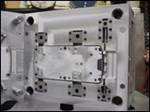Scanner Touch Tool Determines Parting Lines on Free Form Parts
A process has been developed that uses a “touch tool” combined with a NextEngine 3-D scanner (Santa Monica, CA) to determine a mold parting line.
A process has been developed that uses a “touch tool” combined with a NextEngine 3-D scanner (Santa Monica, CA) to determine a mold parting line. The process was created in response to the challenge of efficiently identifying and transposing into a digital format the parting line of an organically shaped mold object.
The process was designed by Reynald Chaput, owner of Ideas in 3D (Torrance, CA)—a scanning service provider—and is a highly accurate system that captures edge data and merges it with the “clouds of point” that are created when surfaces are digitized. Chaput points out that the fundamental problem with scanning is that a great deal of data ends up in a point cloud. “None of the point data can ever land on the edges,” Chaput says.
A Dual System
Ten years ago, Chaput decided those two systems were necessary to determine parting lines—one for surfaces and one for edges. He couldn’t find a scanner designed for edges, so he designed and built his own. The READ (Reverse Engineering and Digitizing) system has a manual probe with a laser that constantly recalibrates the probe’s exact location. “This system does not generate point clouds, it just does edges,” Chaput notes.
Establishing the parting line and shut-off surfaces are critical for mold work. “The job will not come out properly if these two steps are not done correctly in the beginning,” Chaput notes. “The parting line is created on the actual part with a ‘touch tool’ and establishes the parameters of the mold’s core and cavity parting planes surfaces and how they will mate. The parting line also determines the quality of the molded piece in terms of flash.”
The new final elements to this system are the NextEngine (Santa Monica, CA) desktop scanner used in conjunction with NextEngine’s RapidWorks—a version of the Powerful Free Form software, RapidForm. “These are the only products that I have seen that can manipulate a cloud of points and are able to create a roller coaster parting line in the form of lines and splines dynamically onto the point cloud,” Chaput explains. “With this system, the user can easily create machinable CAD geometry from the .igs parting line and create NURBS parting planes in any CAD software. In addition to merging edge and surface files, this software can convert digitized points into triangles such as .stl (stereolithography tessellation language) systems. Then, .stl files or triangle files can be cut with any CNC machine—provided that one has the proper machining software to create the programs.”
Chaput’s personal preference for creating the programs from .stl files is PowerMill from software manufacturer Delcam International (Windsor, ON). “This product cannot gouge because compared to machining hundreds of surfaces, the user is only machining one triangle mesh that cannot be pierced or violated,” Chaput explains. “It also is very well suited for the CAM programming of the laser scanning process.”
Lastly, Chaput adds that this new technology allows his company to accept complex, free form work with no worries. “On molds this complex, it’s nice to be able to accept this complex work and go to church on Sunday instead of the welder.”
Related Content
How to Fix Predicted Warpage Before It Happens with Windage and CAD Model Morphing
Applying windage and model-morphing techniques saved toolmaker/molder Sturgis Molded Products the time, cost, headaches of multiple part/mold design iteration loops, cumbersome cooling fixtures, and long molding cycles.
Read MoreFour Micro Tooling Considerations
Issues involving gating, ejection, mold splits and direction of pull are of special concern when it comes to micro tooling.
Read MoreHow to Analyze and Optimize Cutting Conditions to Reduce Cycle Time
Plastic injection mold design and manufacturing company puts NC program optimization software module to the test. The results were surprising.
Read MoreMold Design Review: The Complete Checklist
Gerardo (Jerry) Miranda III, former global tooling manager for Oakley sunglasses, reshares his complete mold design checklist, an essential part of the product time and cost-to-market process.
Read MoreRead Next
New Design Strategy for Generating Hybrid Aluminum Tooling
Design, machining and analysis software aids in aluminum mold manufacture.
Read MoreHow to Use Continuing Education to Remain Competitive in Moldmaking
Continued training helps moldmakers make tooling decisions and properly use the latest cutting tool to efficiently machine high-quality molds.
Read MoreHow to Use Strategic Planning Tools, Data to Manage the Human Side of Business
Q&A with Marion Wells, MMT EAB member and founder of Human Asset Management.
Read More








.jpg;maxWidth=300;quality=90)












